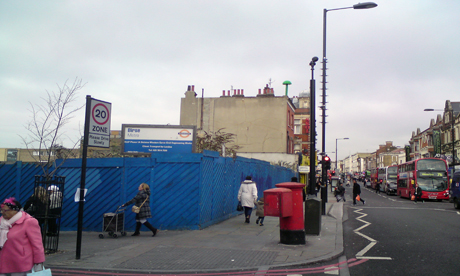Boris Johnson to address local concerns over eight storey ‘gated’ development proposals

Kingsland High Street Dalston. Photograph: Eoin O'Donnell
Mayor Boris Johnson has agreed to meet residents fighting a proposal for eight-storey ‘gated community’ on Kingsland Road just north of Dalston Junction railway station.
The plans run contrary to council guidelines of four to six storeys for the site, which is owned by Transport for London (TfL) and located directly above Dalston Junction’s reinstated train tunnels.
Mayor Johnson committed to meet campaigners after local resident and Conservative London Assembly member, Andrew Boff, urged that previous “crazy schemes” in the area were not repeated.
“I don’t think TfL really care about Dalston,” he said. “The last time TfL got involved in Dalston we ended up demolishing heritage buildings to erect the windswept Dalston Square and building a bus stop that cost £63m where only one bus ever stops.”
As well as enclosing and reducing light to listed buildings to below British standards, the development will have minimal affordable housing and no public green space in an area of London that is in need of both, according to the campaign group OPEN Dalston.
The group’s founder, Bill Parry-Davies, has queried the benefit to the public of proposals in light of TfL’s status as a public body that acquired the sites at the public’s expense. He has also pointed out that TfL received a subsidy from Hackney Council for the development of over £1.3million.
Mr Parry-Davies said the proposal for a major gated community in Dalston is unprecedented and that “for TfL and Hackney to spend public money on a private development with so little public benefit is a slap in the face for Dalston”.

Please explain how the proposed buildings constitue a 'gated community'. As far as I have understood, they are conventional blocks of flats, with communal roof terraces. Presumable the doors, like in most blocks of flats, will be locked. Is it because they have roof terraces that aren't open to the public? Please let me know where it is common that residential roof terraces are open to the public. Please also explain how the proposal is 'unprecedented'. The lack of affordable housing is of course a problem, but I find your terms seriously misrepresentative.
ReplyDeleteDavid - the Western Curve sites are railway land owned by TfL, a public body. The scheme is subsidised by a substantial financial contribution by the local authority. The development proposal makes no provision for any public open or green spaces on the sites nor provides for any public access into or through the sites. The developments occupy the entire sites and creates a private enclave of almost exclusively (90%) unaffordable homes for sale where all green and amenity space is enclosed within the development. The design effectively creates a barrier between the development and the rest of Dalston rather than an accessible mixed-tenure, diverse, sustainable community.
DeleteWe consider this has all the characteristics of a gated community. You consider it is a conventional block of flats with a locked entrance door. We differ.
Then presumably OPEN Dalston would describe a typical Victorian conversion as a "gated community" since they too would have "all green and amenity space enclosed within the development"?
DeleteAbusing a term can render it obsolete and, once again, draws into question the credibility of the abuser;
http://en.wikipedia.org/wiki/Gated_community
If we are to have an honest debate about development in Hackney then we should at least aspire to be honest.
A converted Victorian house in multiple occupation with a shared garden would not meet the Wikipedia (or any other) definiton of gated 'community' so far as we are aware. However TfL's plan is for 59 flats within the redeveloped northern site on the Westrn Curve. The currently public land there with potential for public green space and amenity will be privatised and enclosed within the development from which the public will be excluded. One could reasonably suggest that, in this case, it would be dishonest to deny that a gated community is what is being proposed.
DeleteWhy do you have to be so negative about everything in Dalston?
ReplyDeleteYour 12 days of Xmas blog was so depressing, and just a repeat of the year before's blog.
As someone pointed out recently, unfortunately you have lost credibility with your constant attacks on anything new planned for the area, especially residential buildings.
Dalston is a great area, and finally it is going to get even better. It makes a change from pound shops, kebabs and council estates.
Please just lighten up a little in 2013.
Yes, Dalston is a great area - we have a vibrant mixed community, a great street market, local heritage, the Eastern Curve garden great venues like Arcola, Vortex, Cafe Oto, Passing Clouds, Rio, a buzzing night life, galleries, coffee shops, social enterprises, independent businesses, restaurants, etc. But we don't think developers should be entitled to do whatever they want and exploit Dalston just for their own advantage. It's not whether sites need development, but how it's done.
Delete